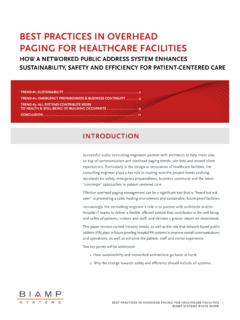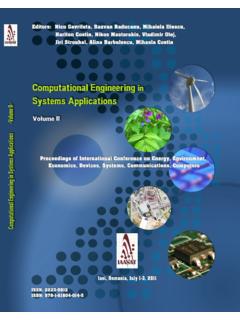Transcription of Adversity and Material Limitations in Patent Practice ...
1 Adversity and Material Limitations in Patent Practice : litigation , Opinions, and prosecution By David Hricik Excerpted with permission from David Hricik & Mercedes Meyer, Ethics: Patent prosecution (Lexis/Nexis 2015-16 ed.) 2 Chapter 10 Adversity and Material Limitations in Patent Practice : litigation , Opinions, and prosecution Scope Choice of Law in Disqualification Matters [1] The Important Role of the Rules in Determining Adversity , Especially in Federal Court or in the USPTO [2] The Questionable Value of Federal Precedent in State Court Adversity and Material Limitations as Ethical Boundaries [1] Introduction [2] The Model Rules and the USPTO Provisions [3] The Meaning of Adversity [4] The Meaning of Material Limitations Conflicts in Patent litigation [1] Introduction [2] Helping Out Behind the Scenes [3]
2 Making Assertions in Pleadings and Motions Adverse in a Case Not Naming a Client, but which Make the Case Against a Client [4] Representing a Patentee in Parallel Co-Pending Patent Suits, Only One of which Is Against a Client [a] Adversity ? [b] Materially Limited? [c] What to Do? [5] Adversity in opinion Practice [a] The Two Existing Decisions [b] What to Do? [6] Adversity from Concurrent Representations in Patent prosecution Conflicts Created by the Property Right in a Patent [1] The Conflict Created by the Right of Priority [2] The Conflict Created by the Right to Exclude Information as a Source of Conflict and Liability [1] Information as a Source of Liability: Trade Secret Misuse [2] Information as a Source of Conflict: Possession of Confidential Information of One Client that Is Material to the Patentability of Another Client s Claim [a] The Federal Circuit s Three Answers [b] The USPTO s Preliminary Answer Is There Adversity in Common prosecution Activities?
3 [1] Introduction [2] What to Do? 3 Scope A basic principle of the fiduciary duty is that a practitioner must be loyal to his client. A practitioner cannot act adversely to a client. But loyalty goes further: loyalty requires that a practitioner represent a client with full vigor. Thus, a practitioner whose representation of a client is materially limited by the practitioner s obligations to anyone including the interests of the practitioner -- else violates the obligations to a current client. Both of these aspects of loyalty are discussed in this chapter. The loyalty principle is weaker once a representation ends. Thus, as Chapter 11 shows, a practitioner may be adverse to a former client, but not in a matter that is substantially related to the work the practitioner did for the client.
4 However, the same principle concerning Material Limitations holds true: if the practitioner is unable to vigorously represent a current client due to a former representation, the practitioner cannot represent the client in that matter. In addition, specific, but narrower, duties of confidentiality remain in force. Choice of Law in Disqualification Matters [1] The Important Role of the Rules in Determining Adversity , Especially in Federal Court or in the USPTO Chapter 3 contains a reasonably comprehensive discussion of choice of law. However, because differences on approaches to conflicts of interest among the courts and the USPTO are sometimes outcome determinative in the context of conflicts of interest, we lay out some additional details here.
5 At the outset, disciplinary rules of a state are just that disciplinary rules. Invariably, they state that they should not be used as a basis for determining disqualification or civil liability but courts routinely use them for those However, the courts disagree on precisely their role: are they controlling minimum standards, or merely guidelines for the court to consider in determining an ethical issue? For example, the Arizona Supreme Court has declined to use the court s own ethical standards as a basis upon which to impose legal malpractice liability, but stated that Arizona s disciplinary rules may provide evidence of how a professional would act, they do not create a duty or establish a standard of care as a matter of law.
6 2 The space between those two propositions is often not great. Thus, while the focus in many parts of this chapter is on disciplinary rules and authorities interpreting them, in actual Practice , the rules may not bind a state court in a disqualification matter. Moreover, federal courts are deeply divided sometimes even within the same circuit on what role state disciplinary rules play in deciding federal ethical issues. That is important because many Patent practitioners litigate beyond their home state. What may be proper in an Arizona state court or in the Fifth Circuit may be entirely inappropriate in the Northern District of California, for example.
7 2 Stirling Bridge, v. Quarles & Brady, LLP, 2009 Ariz. App. Unpub. LEXIS 968 (Ariz. Ct. App. Dec. 10, 2009) (quoting Stanley v. McCarver, 92 849 (Ariz. 2004)) (quotation marks and citations omitted). 4 This is exacerbated, because federal courts disagree sometimes openly, sometimes unknowingly -- on what role, if any, state disciplinary rules play in determining ethical issues that arise in federal court. One common approach some circuits or district courts follow in determining ethical issues facing counsel appearing in federal court litigation is to disqualify counsel if it is appropriate under either federal common law or ethical rules (state or Model Rules) as adopted by a court s local Practice before the USPTO, as shown in Chapters 2 and 3, is governed by the USPTO s own unique code, and now rules.
8 Generally speaking, application of most choice-of-law rules would end up causing a tribunal to apply only the PTO Code or the USPTO Rules to a practitioner s conduct occurring before the Office, as we saw in Chapter 3. In other words, even if a disciplinary proceeding were brought by the Illinois, Michigan, or Iowa bar, that bar would likely apply the PTO Code or only the USPTO Rules to the Whether the USPTO Rules or PTO Code applies depends on the timing of the alleged misconduct at issue. But determining that the PTO Code or USPTO Rules applies does not give the complete answer as to what law applies. Instead, and as shown in Chapter 3 and amplified here, in deciding petitions to disqualify the USPTO has taken different views of whether even if a matter is adverse to a current client the petition to disqualify should be granted.
9 Unsettling as it is, even if the USTPO denied a petition to disqualify, the OED nevertheless could discipline the lawyer. Adversity and Material Limitations as Ethical Boundaries [1] Introduction Two general principles govern the obligations that outside counsel owe to current clients, and are found in all ethical rules and the law of fiduciaries or agents. One relates to representations that are directly adverse to a current client; the other relates to pulling punches when the practitioner s duties to someone else, including the practitioner herself, materially limit her ability to represent a client. [2] The Model Rules and the USPTO Provisions MODEL RULE contains two prohibitions concerning conflicts of interest between two current clients: (a) a lawyer may not represent one client directly adverse to another client ; and (b) he may not represent a client if the representation of that client may be materially limited by the lawyer s responsibilities to another client.
10 12 Under the principle of imputed disqualification, if 3 Cole v. Ruidoso Mun. Schools, 43 1373 (10th Cir. 1994). See Hermann v. Gutterguard, Inc., 199 F. App x 745 (11th Cir. Sept. 11, 2006). 9 See, , MODEL RULE (b)(1) (if lawyer s conduct occurs before a tribunal, its rules should apply); ILL. R. (b)(1) (same); MICH. R. (b)(1) (same). 12 Rule provides: Except as provided in paragraph (b), a lawyer shall not represent a client if the representation involves a concurrent conflict of interest. A concurrent conflict of interest exists if: the representation of one client will be directly adverse to another client; or 5 one lawyer may not undertake a representation, generally no lawyer in the firm Clients can consent, under some circumstances, after full disclosure, as discussed in the chapter on consent.





